Estimation Method of Interpass Time for the Control of Temperature during a Directed Energy Deposition Process of a Ti–6Al–4V Planar Layer
Abstract
1. Introduction
2. Analysis of Wire Feeding-Type DED Process
2.1. Wire Feeding-Type DED Process
2.2. Finite Element Models
2.2.1. Overlapping Bead Profile for Planar Layer Deposition
2.2.2. Heat Source Model
2.2.3. Material Properties and Boundary Conditions
3. Proposed Estimation of Proper Interpass Time Using Regression Analysis
4. Results and Discussion
4.1. Temperature Distributions
4.1.1. Interpass Temperature Using Selected Proper Interpass Time Scheme
4.1.2. Depth of Melt Pool and Heat-Affected Zone
4.2. Thermo-Mechanical Characteristics during Planar Layer Deposition
4.2.1. Vertical Displacement
4.2.2. Induced Residual Stress
5. Conclusions
Author Contributions
Funding
Conflicts of Interest
Abbreviations
| DED | Directed Energy Deposition |
| LENS | Laser Engineered Net Shaping |
| FE | Finite Element |
| FEA | Finite Element Analysis |
| HAZ | Heat Affected Zone |
| CITS | Constant Interpass Time Scheme |
| PITS | Proper Interpass Time Scheme |
References
- Babu, B.; Lundbäck, A.; Lindgren, L.-E. Simulation of Ti-6Al-4V Additive Manufacturing Using Coupled Physically Based Flow Stress and Metallurgical Model. Materials 2019, 12, 3844. [Google Scholar] [CrossRef] [PubMed]
- Hong, M.-P.; Kim, W.-S.; Sung, J.-H.; Kim, D.-H.; Bae, K.-M.; Kim, Y.-S. High-performance eco-friendly trimming die manufacturing using heterogeneous material additive manufacturing technologies. Int. J. Precis. Eng. Manuf. Technol. 2018, 5, 133–142. [Google Scholar] [CrossRef]
- Caiazzo, F.; Alfieri, V. Simulation of Laser-assisted Directed Energy Deposition of Aluminum Powder: Prediction of Geometry and Temperature Evolution. Materials 2019, 12, 2100. [Google Scholar] [CrossRef] [PubMed]
- Caiazzo, F.; Alfieri, V. Laser-Aided Directed Energy Deposition of Steel Powder over Flat Surfaces and Edges. Materials 2018, 11, 435. [Google Scholar] [CrossRef]
- Dass, A.; Moridi, A. State of the Art in Directed Energy Deposition: From Additive Manufacturing to Materials Design. Coatings 2019, 9, 418. [Google Scholar] [CrossRef]
- Ahn, D.-G. Applications of laser assisted metal rapid tooling process to manufacture of molding & forming tools—State of the art. Int. J. Precis. Eng. Manuf. 2011, 12, 925–938. [Google Scholar] [CrossRef]
- Jackson, M.A.; Van Asten, A.; Morrow, J.D.; Min, S.; Pfefferkorn, F.E. Energy Consumption Model for Additive-Subtractive Manufacturing Processes with Case Study. Int. J. Precis. Eng. Manuf. Technol. 2018, 5, 459–466. [Google Scholar] [CrossRef]
- Graf, B.; Gumenyuk, A.; Rethmeier, M. Laser Metal Deposition as Repair Technology for Stainless Steel and Titanium Alloys. Phys. Procedia 2012, 39, 376–381. [Google Scholar] [CrossRef]
- Torgerson, T.; Mantri, S.; Banerjee, R.; Scharf, T.W. Room and elevated temperature sliding wear behavior and mechanisms of additively manufactured novel precipitation strengthened metallic composites. Wear 2019, 942–951. [Google Scholar] [CrossRef]
- Piscopo, G.; Atzeni, E.; Salmi, A. A Hybrid Modeling of the Physics-Driven Evolution of Material Addition and Track Generation in Laser Powder Directed Energy Deposition. Materials 2019, 12, 2819. [Google Scholar] [CrossRef] [PubMed]
- Chua, B.L.; Lee, H.J.; Ahn, D.-G.; Kim, J.G. Influence of Angle of Corner Deposition on Temperature and Residual Stress Distributions in the Vicinity of the Deposited Region by a Ti-6Al-4V Wire-Feeding Type of Direct Energy Deposition Process. J. Korean Soc. Precis. Eng. 2018, 35, 853–859. [Google Scholar] [CrossRef]
- Chua, B.L.; Ahn, D.-G.; Kim, J.-G. Influences of deposition strategies on thermo-mechanical characteristics of a multilayer part deposited by a wire feeding type DED process. J. Mech. Sci. Technol. 2019, 33, 5615–5622. [Google Scholar] [CrossRef]
- Jang, Y.-H.; Ahn, D.-G.; Kim, J.; Kim, W.-S. Re-Melting Characteristics of a Stellite21 Deposited Part by Direct Energy Deposition Process Using a Pulsed Plasma Electron Beam with a Large Irradiation Area. Int. J. Precis. Eng. Manuf. Technol. 2018, 5, 467–477. [Google Scholar] [CrossRef]
- Wang, L.; Felicelli, S.D.; Gooroochurn, Y.; Wang, P.; Horstemeyer, M. Optimization of the LENS® process for steady molten pool size. Mater. Sci. Eng. A 2008, 474, 148–156. [Google Scholar] [CrossRef]
- Crespo, A.; Vilar, R. Finite element analysis of the rapid manufacturing of Ti–6Al–4V parts by laser powder deposition. Scr. Mater. 2010, 63, 140–143. [Google Scholar] [CrossRef]
- Manvatkar, V.; De, A.; Debroy, T. Spatial variation of melt pool geometry, peak temperature and solidification parameters during laser assisted additive manufacturing process. Mater. Sci. Technol. 2014, 31, 924–930. [Google Scholar] [CrossRef]
- Yang, Q.; Zhang, P.; Cheng, L.; Min, Z.; Chyu, M.; To, A.C. Finite element modeling and validation of thermomechanical behavior of Ti-6Al-4V in directed energy deposition additive manufacturing. Addit. Manuf. 2016, 12, 169–177. [Google Scholar] [CrossRef]
- Ding, J.; Colegrove, P.; Mehnen, J.; Ganguly, S.; Almeida, P.S.; Wang, F.; Williams, S. Thermo-mechanical analysis of Wire and Arc Additive Layer Manufacturing process on large multi-layer parts. Comput. Mater. Sci. 2011, 50, 3315–3322. [Google Scholar] [CrossRef]
- Farahmand, P.; Kovacevic, R. An experimental–numerical investigation of heat distribution and stress field in single- and multi-track laser cladding by a high-power direct diode laser. Opt. Laser Technol. 2014, 63, 154–168. [Google Scholar] [CrossRef]
- Denlinger, E.R.; Michaleris, P. Effect of stress relaxation on distortion in additive manufacturing process modeling. Addit. Manuf. 2016, 12, 51–59. [Google Scholar] [CrossRef]
- Woo, Y.-Y.; Han, S.-W.; Oh, I.-Y.; Moon, Y.H.; Ha, W. Control of Directed Energy Deposition Process to Obtain Equal-Height Rectangular Corner. Int. J. Precis. Eng. Manuf. 2019, 20, 2129–2139. [Google Scholar] [CrossRef]
- Li, W.; Soshi, M. Modeling analysis of the effect of laser transverse speed on grain morphology during directed energy deposition process. Int. J. Adv. Manuf. Technol. 2019, 103, 3279–3291. [Google Scholar] [CrossRef]
- Chen, Z.; Guo, X.; Shi, J. Hardness Prediction and Verification Based on Key Temperature Features During the Directed Energy Deposition Process. Int. J. Precis. Eng. Manuf. Technol. 2020, 1–17. [Google Scholar] [CrossRef]
- ASTM F3187-16 Standard Guide for Directed Energy Deposition of Metals; ASTM International: West Conshohocken, PA, USA, 2016.
- ANSI/AWS A3.0-94 Standard Welding Terms and Definitions; American Welding Society: Miami, FL, USA, 1994.
- Ma, Y.; Cuiuri, D.; Shen, C.; Li, H.; Pan, Z. Effect of interpass temperature on in-situ alloying and additive manufacturing of titanium aluminides using gas tungsten arc welding. Addit. Manuf. 2015, 8, 71–77. [Google Scholar] [CrossRef]
- Cunningham, C.; Flynn, J.; Shokrani, A.; Dhokia, V.; Newman, S. Invited review article: Strategies and processes for high quality wire arc additive manufacturing. Addit. Manuf. 2018, 22, 672–686. [Google Scholar] [CrossRef]
- Derekar, K.; Lawrence, J.; Melton, G.; Addison, A.; Zhang, X.; Xu, L. Influence of Interpass Temperature on Wire Arc Additive Manufacturing (WAAM) of Aluminium Alloy Components. MATEC Web Conf. 2019, 269, 05001. [Google Scholar] [CrossRef]
- Vázquez, L.; Rodríguez, N.; Alberdi, E.; Álvarez, P. Influence of interpass cooling conditions on microstructure and tensile properties of Ti-6Al-4V parts manufactured by WAAM. Weld. World 2020, 64, 1–12. [Google Scholar] [CrossRef]
- Lee, Y.S.; Bandari, Y.; Simunovic, S.; Richardson, B.; Kirka, M.M. Correlations of interlayer time with distortion of large Ti–6Al–4V components in laser metal deposition with wire. In Proceedings of the 29th Annual International Solid Freeform Fabrication Symposium, Austin, TX, USA, 13–15 August 2018; pp. 606–622. [Google Scholar]
- Lu, X.; Zhou, Y.F.; Xing, X.L.; Shao, L.Y.; Yang, Q.X.; Gao, S.Y. Open-source wire and arc additive manufacturing system: Formability, microstructures, and mechanical properties. Int. J. Adv. Manuf. Technol. 2017, 93, 2145–2154. [Google Scholar] [CrossRef]
- Lu, X.; Lin, X.; Chiumenti, M.; Cervera, M.; Li, J.; Ma, L.; Wei, L.; Hu, Y.; Huang, W. Finite element analysis and experimental validation of the thermomechanical behavior in laser solid forming of Ti-6Al-4V. Addit. Manuf. 2018, 21, 30–40. [Google Scholar] [CrossRef]
- Montevecchi, F.; Venturini, G.; Grossi, N.; Scippa, A.; Campatelli, G. Idle time selection for wire-arc additive manufacturing: A finite element-based technique. Addit. Manuf. 2018, 21, 479–486. [Google Scholar] [CrossRef]
- Lee, Y.; Bandari, Y.; Nandwana, P.; Gibson, B.T.; Richardson, B.; Simunovic, S. Effect of Interlayer Cooling Time, Constraint and Tool Path Strategy on Deformation of Large Components Made by Laser Metal Deposition with Wire. Appl. Sci. 2019, 9, 5115. [Google Scholar] [CrossRef]
- Geng, H.; Li, J.; Xiong, J.; Lin, X. Optimisation of interpass temperature and heat input for wire and arc additive manufacturing 5A06 aluminium alloy. Sci. Technol. Weld. Join. 2016, 22, 472–483. [Google Scholar] [CrossRef]
- E Silva, R.H.G.; Rocha, P.C.J.; Rodrigues, M.B.; Pereira, M.; Galeazzi, D. Analysis of Interlayer Idle Time as a Temperature Control Technique in Additive Manufacturing of Thick Walls by Means of CMT and CMT Pulse Welding Processes. Soldagem Inspeção 2020, 25. [Google Scholar] [CrossRef]
- Kim, J.; Lee, C.-W. Laser Assisted Additive Manufacturing by Rotating Metal Wire Feeder. J. Korean Soc. Precis. Eng. 2018, 35, 847–852. [Google Scholar] [CrossRef]
- Chua, B.L.; Lee, H.J.; Ahn, D.-G.; Kim, J.G. Investigation of Penetration Depth and Efficiency of Applied Heat Flux in a Directed Energy Deposition Process with Feeding of Ti-6Al-4V Wires. J. Korean Soc. Precis. Eng. 2018, 35, 211–217. [Google Scholar] [CrossRef]
- Suryakumar, S.; Karunakaran, K.; Bernard, A.; Chandrasekhar, U.; Raghavender, N.; Sharma, D. Weld bead modeling and process optimization in Hybrid Layered Manufacturing. Comput. Des. 2011, 43, 331–344. [Google Scholar] [CrossRef]
- Cao, Y.; Zhu, S.; Liang, X.; Wang, W. Overlapping model of beads and curve fitting of bead section for rapid manufacturing by robotic MAG welding process. Robot. Comput. Manuf. 2011, 27, 641–645. [Google Scholar] [CrossRef]
- Xiong, J.; Zhang, G.; Gao, H.; Wu, L. Modeling of bead section profile and overlapping beads with experimental validation for robotic GMAW-based rapid manufacturing. Robot. Comput. Manuf. 2013, 29, 417–423. [Google Scholar] [CrossRef]
- Ding, D.; Pan, Z.; Cuiuri, D.; Li, H. A multi-bead overlapping model for robotic wire and arc additive manufacturing (WAAM). Robot. Comput. Manuf. 2015, 31, 101–110. [Google Scholar] [CrossRef]
- Li, Y.; Sun, Y.; Han, Q.; Zhang, G.; Horváth, I. Enhanced beads overlapping model for wire and arc additive manufacturing of multi-layer multi-bead metallic parts. J. Mater. Process. Technol. 2018, 252, 838–848. [Google Scholar] [CrossRef]
- Azizpour, M.; Ghoreishi, M.; Khorram, A. Numerical simulation of laser beam welding of Ti6Al4V sheet. J. Appl. Comput. Mech. 2015, 4, 145–154. [Google Scholar]
- Lindgren, L.-E.; Lundbäck, A.; Fisk, M.; Pederson, R.; Andersson, J. Simulation of additive manufacturing using coupled constitutive and microstructure models. Addit. Manuf. 2016, 12, 144–158. [Google Scholar] [CrossRef]
- Romano, J.; Ladani, L.; Sadowski, M. Thermal Modeling of Laser Based Additive Manufacturing Processes within Common Materials. Procedia Manuf. 2015, 1, 238–250. [Google Scholar] [CrossRef]
- SYSWELD 2016.0. In Visual-Weld 12.0; ESI Group: Paris, France, 2016.
- Carpenter Technology Corporation Titanium Alloy Ti 6Al-4V Datasheet. Available online: http://cartech.ides.com/datasheet.aspx?i=101&E=269&FMT=PRINT (accessed on 7 January 2020).
- Wang, X.; Gong, X.; Chou, K. Scanning Speed Effect on Mechanical Properties of Ti-6Al-4V Alloy Processed by Electron Beam Additive Manufacturing. Procedia Manuf. 2015, 1, 287–295. [Google Scholar] [CrossRef]
- Incropera, F.P.; DeWitt, D.P.; Bergman, T.L.; Lavine., A. Incropera’s Principles of Heat and Mass Transfer; John Wiley & Sons: New York, NY, USA, 2017; ISBN 978-1-119-38291-1. [Google Scholar]
- Boivineau, M.; Cagran, C.; Doytier, D.; Eyraud, V.; Nadal, M.-H.; Wilthan, B.; Pottlacher, G. Thermophysical Properties of Solid and Liquid Ti-6Al-4V (TA6V) Alloy. Int. J. Thermophys. 2006, 27, 507–529. [Google Scholar] [CrossRef]
- Brandl, E.; Michailov, V.; Viehweger, B.; Leyens, C. Deposition of Ti–6Al–4V using laser and wire, part I: Microstructural properties of single beads. Surf. Coatings Technol. 2011, 206, 1120–1129. [Google Scholar] [CrossRef]
- Gibson, I.; Rosen, D.; Stucker, B. Additive Manufacturing Technologies; Springer Science and Business Media LLC: New York, NY, USA, 2015. [Google Scholar]

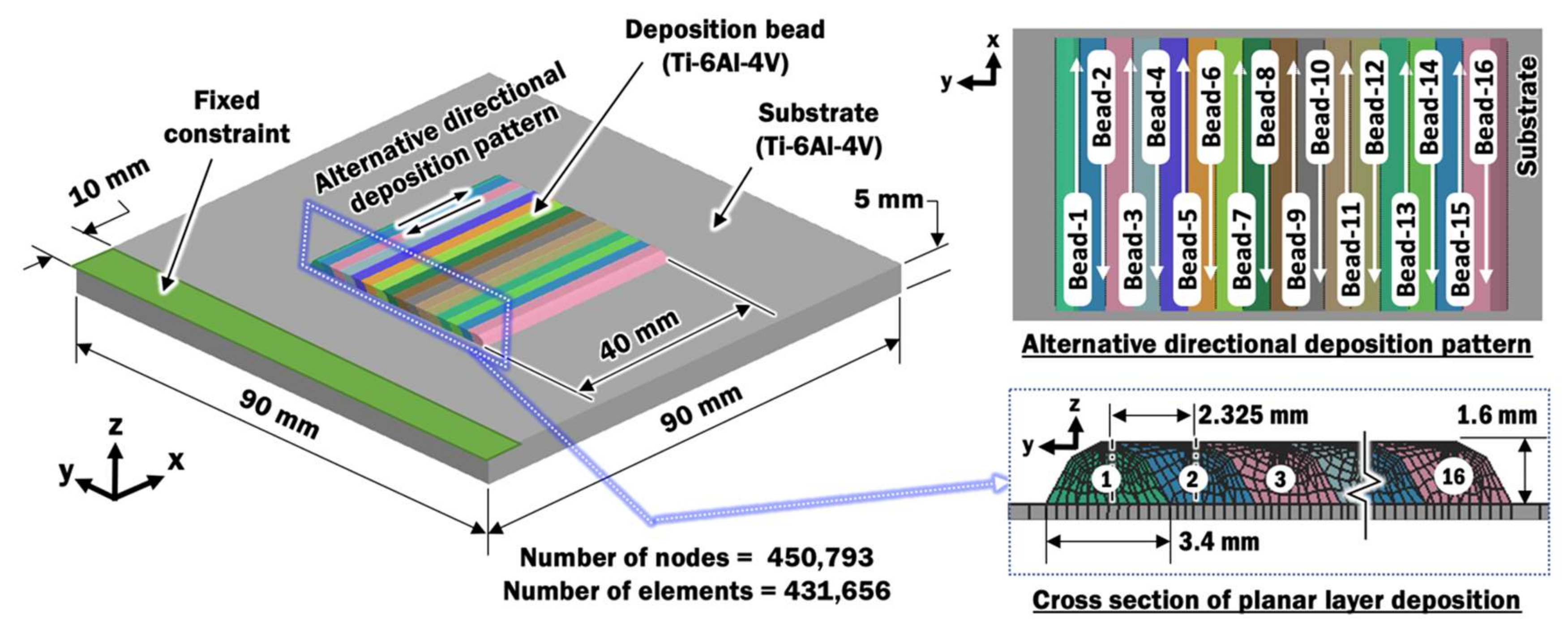



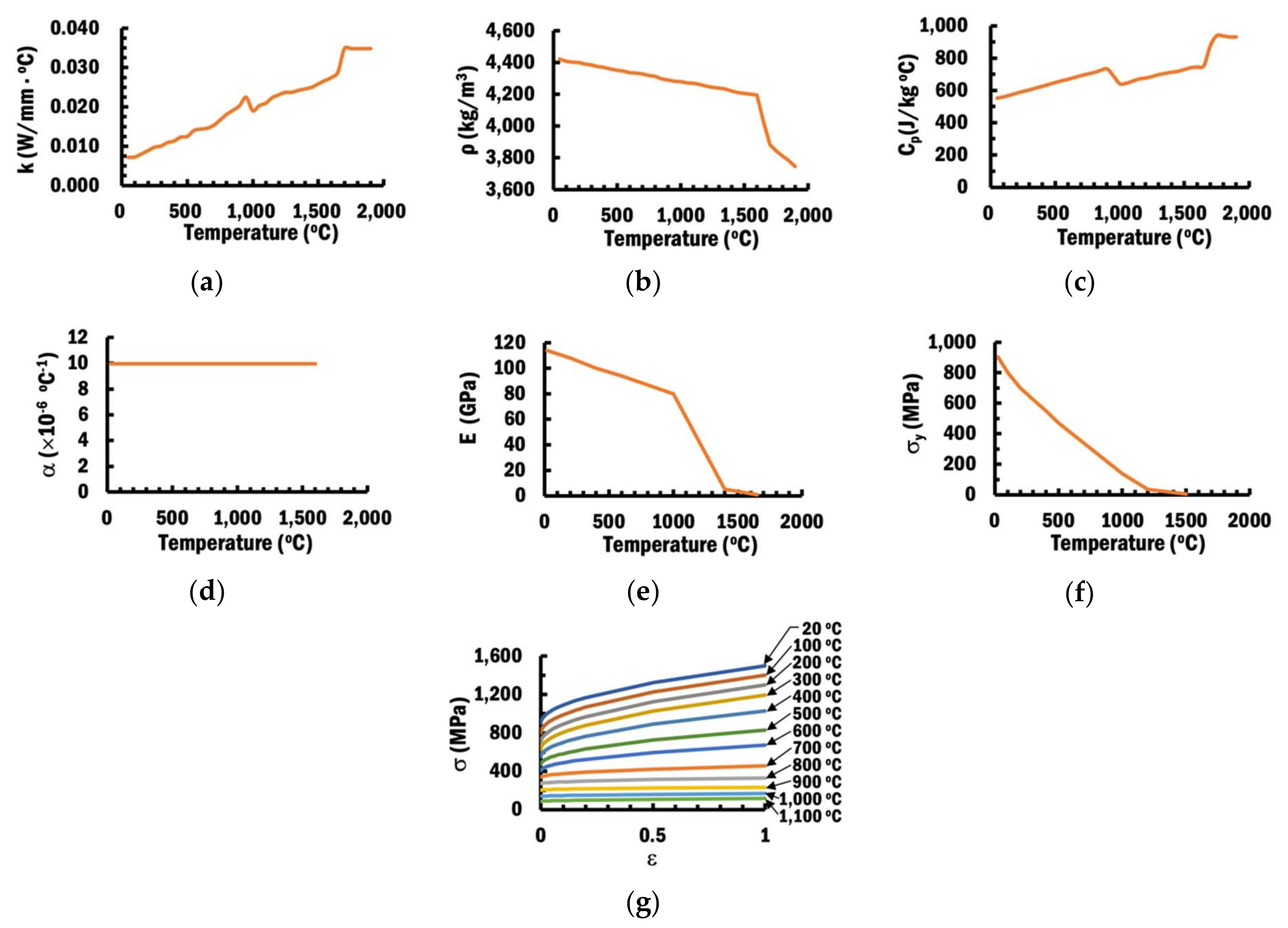
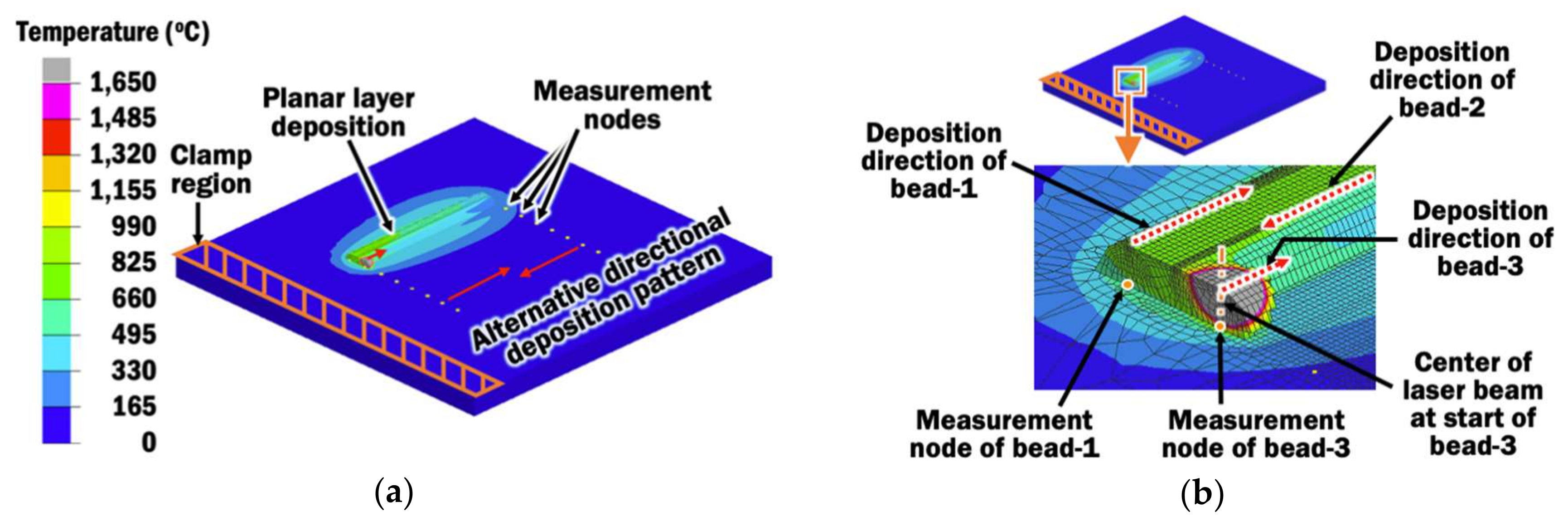



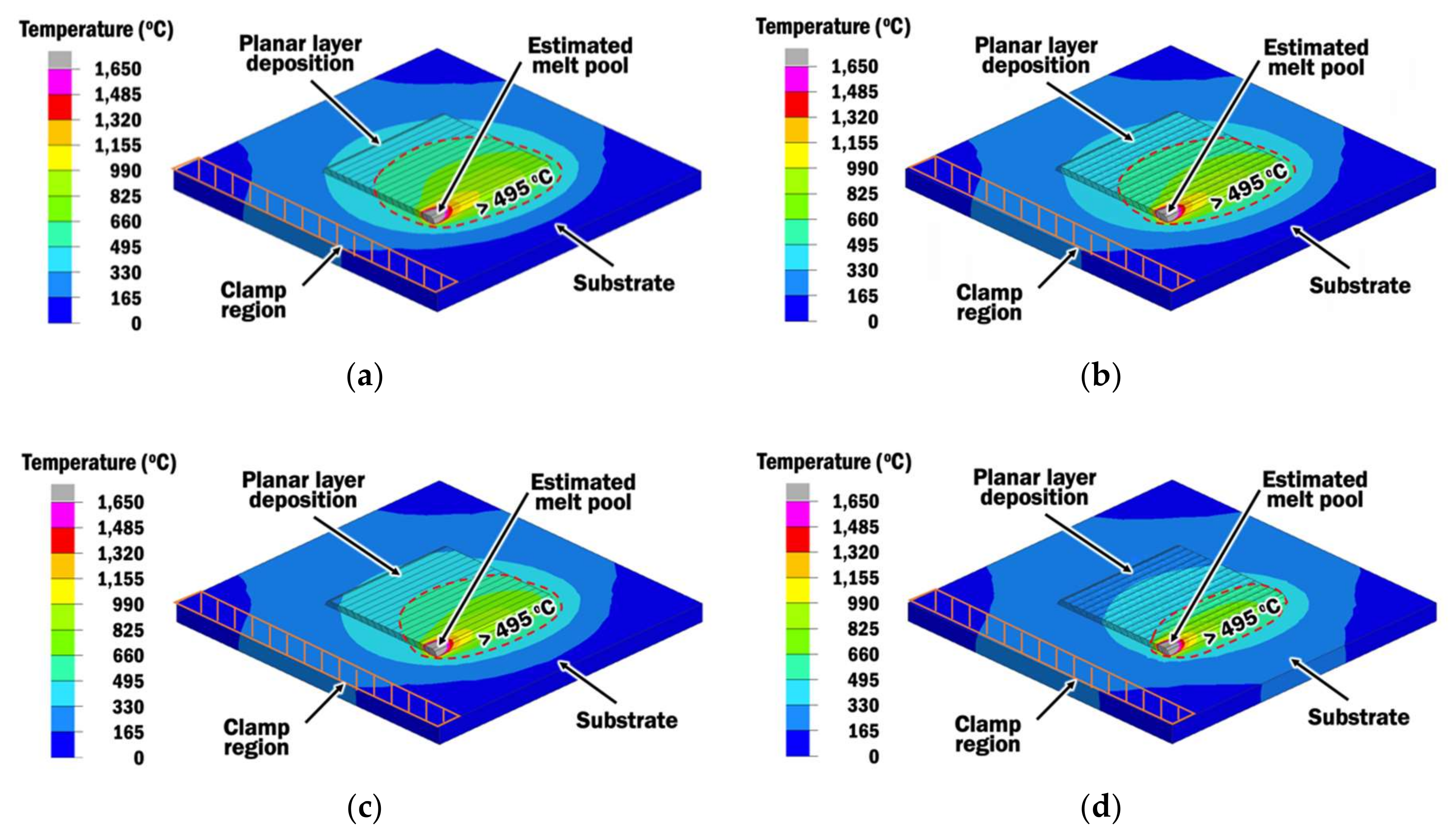
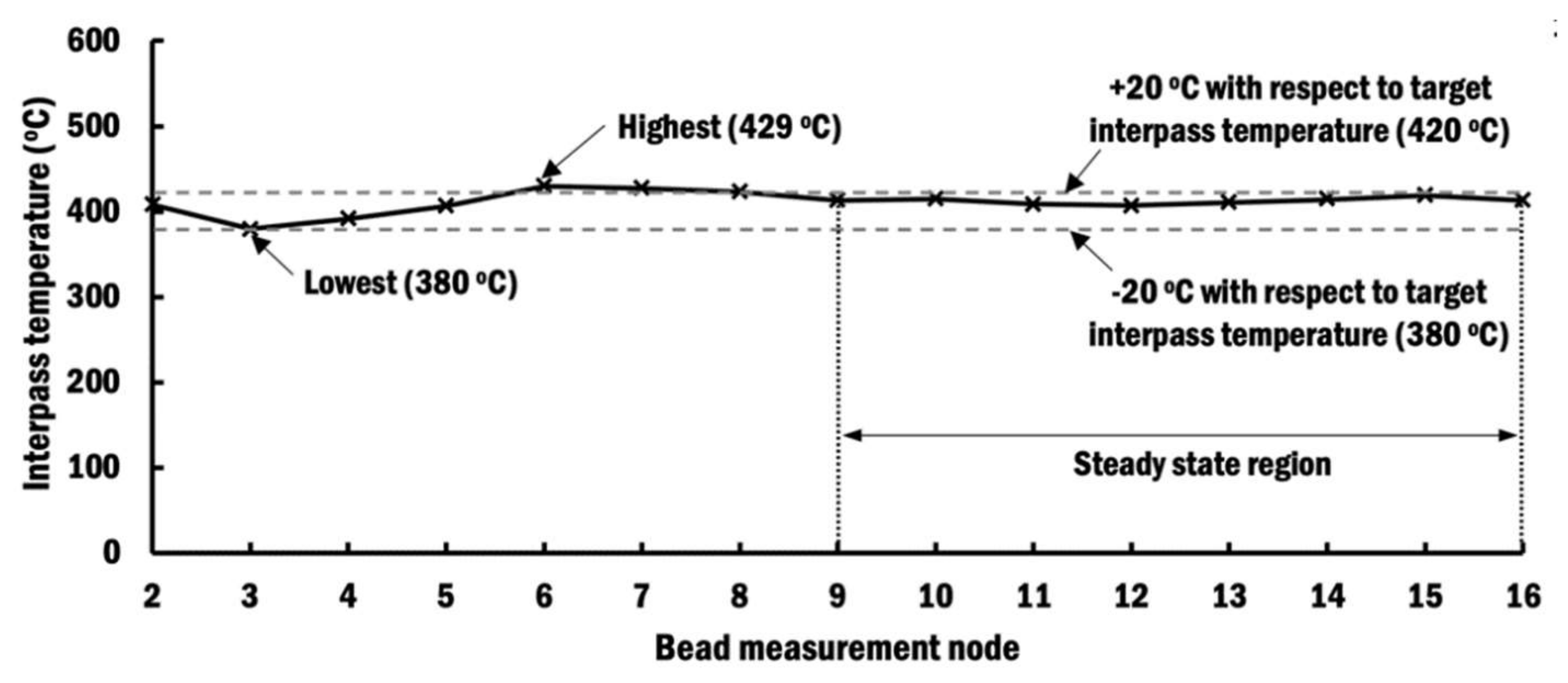
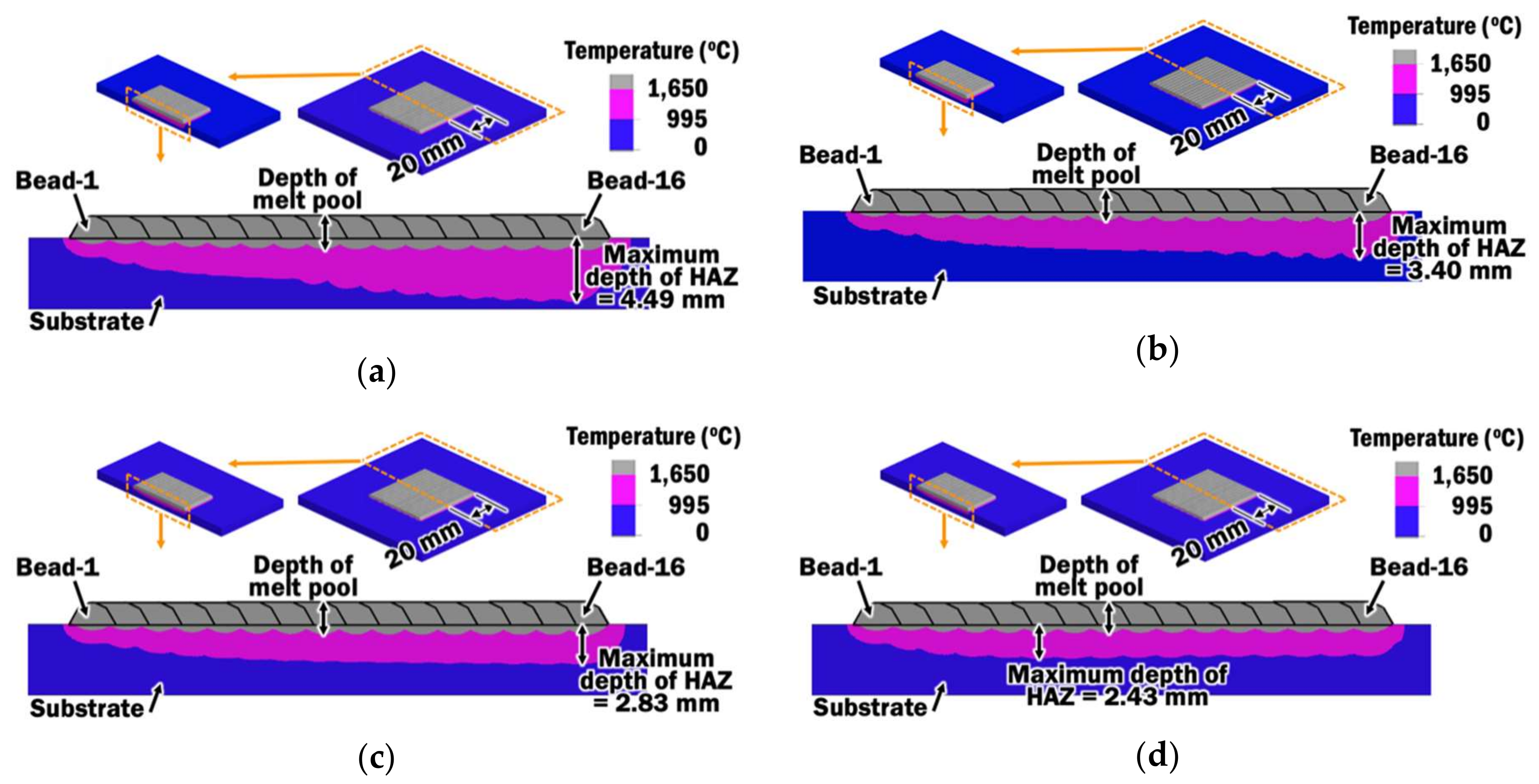





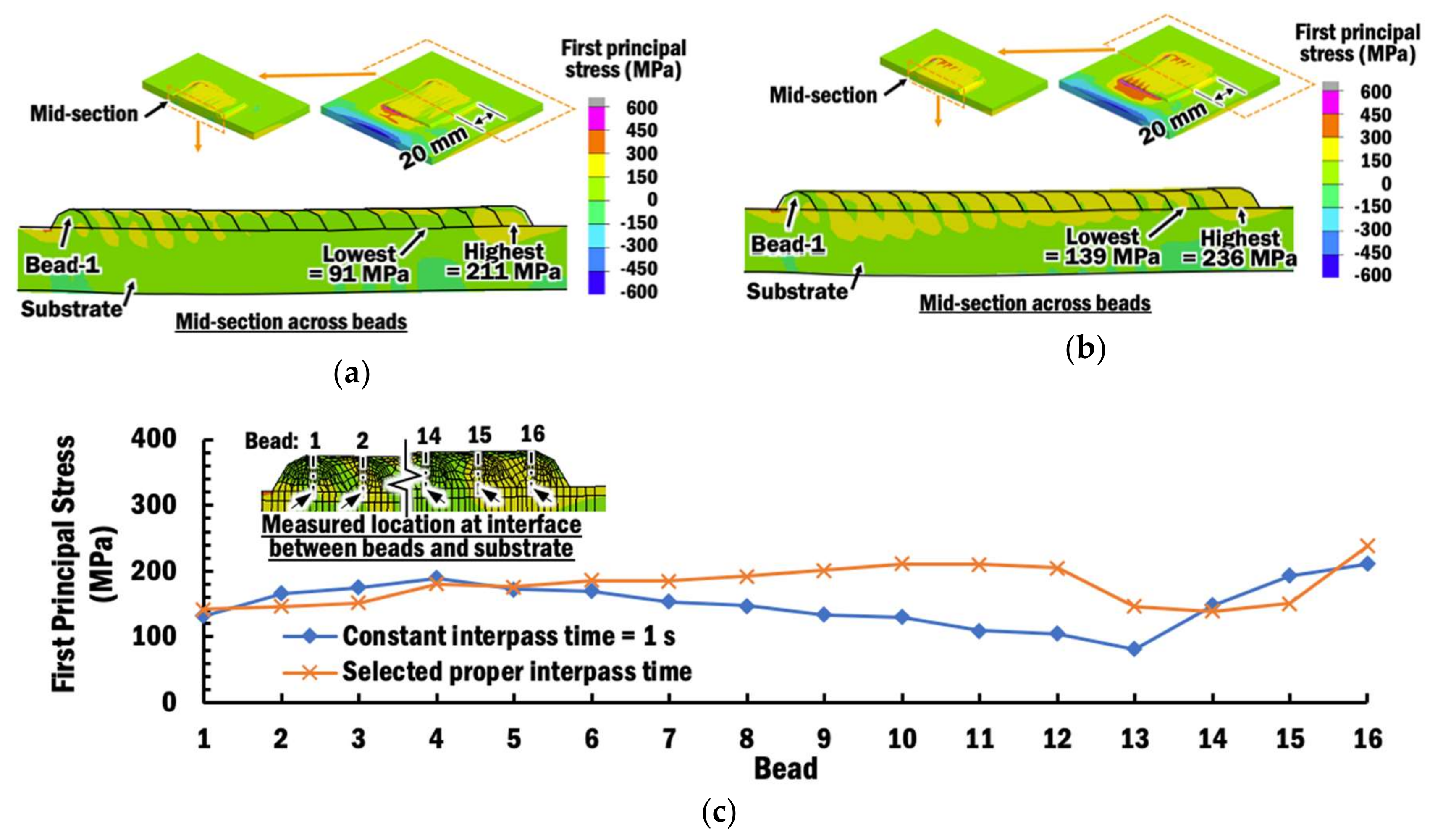


| Power of Laser (P, kW) | Travel Speed (v, mm/s) | Cross-Section Area of Polygonal-Shaped Profile (Ap, mm2) | Height of Bead (hb, mm) | Center Distance between Beads (gb, mm) | Center Distance-to-Width Ratio (gw) |
|---|---|---|---|---|---|
| 1.5 | 8 | 3.720 | 1.6 | 2.325 | 0.684 |
| Power of Laser (P, kW) | Efficiency of Laser (η, %) | Penetration Depth (dp, mm) | Effective Beam Radius at Surface of Bead (re, mm) | Effective Beam Radius at dp (ri, mm) |
|---|---|---|---|---|
| 1.5 | 60 | 0.2 | 0.750 | 0.375 |
Publisher’s Note: MDPI stays neutral with regard to jurisdictional claims in published maps and institutional affiliations. |
© 2020 by the authors. Licensee MDPI, Basel, Switzerland. This article is an open access article distributed under the terms and conditions of the Creative Commons Attribution (CC BY) license (http://creativecommons.org/licenses/by/4.0/).
Share and Cite
Chua, B.-L.; Ahn, D.-G. Estimation Method of Interpass Time for the Control of Temperature during a Directed Energy Deposition Process of a Ti–6Al–4V Planar Layer. Materials 2020, 13, 4935. https://doi.org/10.3390/ma13214935
Chua B-L, Ahn D-G. Estimation Method of Interpass Time for the Control of Temperature during a Directed Energy Deposition Process of a Ti–6Al–4V Planar Layer. Materials. 2020; 13(21):4935. https://doi.org/10.3390/ma13214935
Chicago/Turabian StyleChua, Bih-Lii, and Dong-Gyu Ahn. 2020. "Estimation Method of Interpass Time for the Control of Temperature during a Directed Energy Deposition Process of a Ti–6Al–4V Planar Layer" Materials 13, no. 21: 4935. https://doi.org/10.3390/ma13214935
APA StyleChua, B.-L., & Ahn, D.-G. (2020). Estimation Method of Interpass Time for the Control of Temperature during a Directed Energy Deposition Process of a Ti–6Al–4V Planar Layer. Materials, 13(21), 4935. https://doi.org/10.3390/ma13214935






